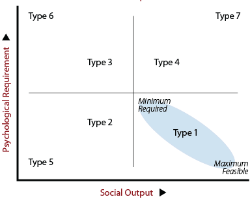Plotting all Types in a Typology
TET: Typology Essences Table
All Types are readily evident to a keen observer as individuals go about life and work seriously in their own particular way. The 7 Types within any Typology can be plotted on a 2x2 Table, called a Typology Essences Table (TET).

The TET is designed to capture use of the Type within the specific psychosocial domain of the Typology. In the TET diagram, an Executing Duality defines the two independent axes which are the essential aspects of that domain. These essences are always:
- the -social i.e. the desired and expected environmental, objective, impersonal, situational output or result … the X-axis; &
- the psycho- i.e. the unavoidable and expected mental, personal, group, or subjective requirement to produce that output … the Y-axis.
The value of a TET is that it allows all Types within a particular Typology to be simultaneously viewed in a meaningful way. Patterns in the TET correspond to:
• characteristic phenomena of the Typology,
• experiences of those strongly identified with one or more Types, and
• social situations in which people find themselves.
The TET shows interesting similarities to the Myers-Briggs Type Indicator![]() (MBTI). The MBTI is a Jungian-inspired questionnaire which categorizes personal activity in rather general ways.
(MBTI). The MBTI is a Jungian-inspired questionnaire which categorizes personal activity in rather general ways.![]() More on the TET & MBTI
More on the TET & MBTI
Location of Types
Following the analysis of the main forms of Typology from first principles, it now appears that there are certain standard patterns when plotted on the TET.
The Root Typology has a distinctive pattern: see diagram below, and details here.
All 7 Principal Typologies have a specific and different pattern. See generic diagram below centre, and the example of decision types.
All Q- or Subsidiary Typologies have a third pattern. See generic diagram below, and the example of ways to interact for benefit.
Better viewing: Use browser zoom if needed.
| Root Typology TET | Principal Typology TET | Subsidiary Typology TET |
|---|---|---|

|

|

|
Maximizing Practical Effectiveness

Survival depends on being practical. So the primary target in all TETs is necessarily in the Lower Right quadrant.
The aspiration is invariably to move from a basic that is weakly effective (near the centre of both axes), to a maximally effective and sophisticated in which everyone participates and contributes strongly, whatever their Type.
Such a direct move as indicated by the arrows in the diagram proves to be quite impossible. It ignores personal needs and capacities as well as social realities.
Given that each Type makes a distinctive and useful contribution, the issue is how to engage them all in a particular enterprise or community. The answer is two-fold:
- have a diversity of individuals filling diverse roles;
- embody values from all the Types within a developing social context.
- Introduction of values is never easy. It must occur in an emotionally-and-logically satisfactory way, if it is to occur at all; and this is the basis for the emergence of a Spiral trajectory for maturation, the final structure in this section.
Originally posted: August 2009; Last updated 15-Jan-2014.
